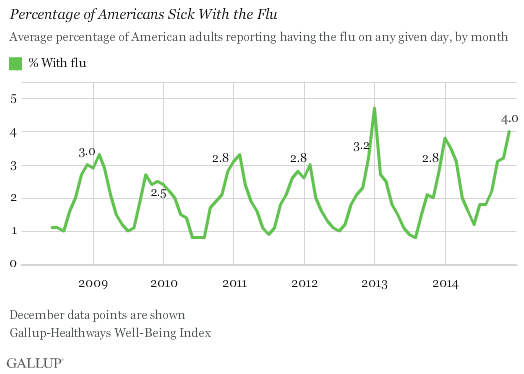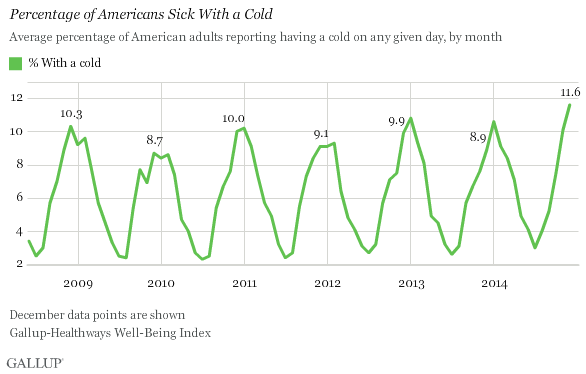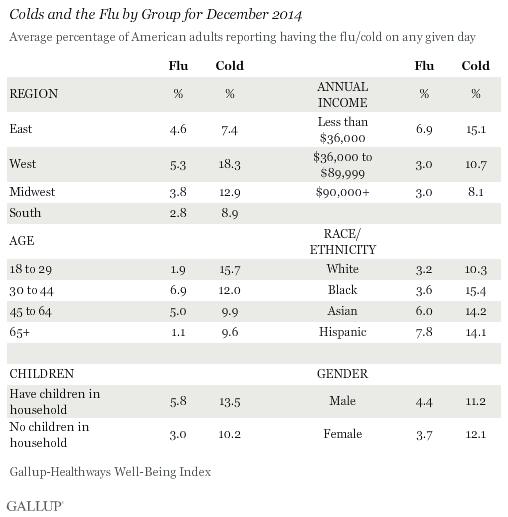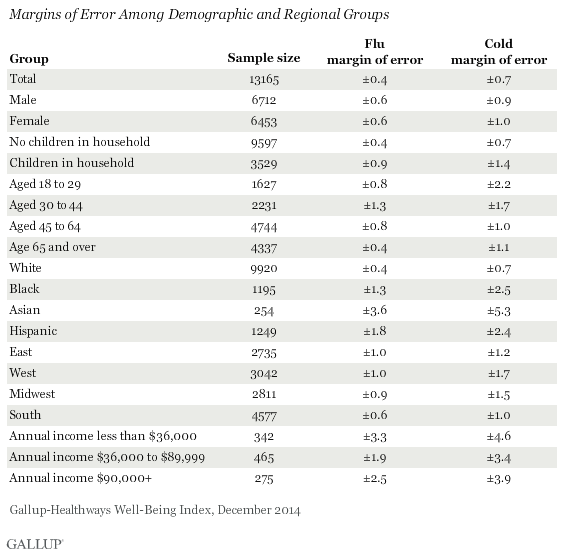Story Highlights
- Daily flu reports averaged 4.0%, highest in December since 2008
- Daily cold reports averaged 11.6%, highest month since 2008
- Lower-income Americans more likely to have cold, flu
WASHINGTON, D.C. -- An average 4.0% of Americans reported being sick with flu on any given day in December. This is higher than all previous Decembers since Gallup began tracking the flu daily in 2008, and is one of the highest rates for any month over the past seven years. The all-time high is 4.7%, measured in January 2013.

Given that reports of having the flu are typically highest in January or February, the 2013-2014 flu season could end up being the worst flu season in Gallup's records. However, it may also be that the flu is peaking early this season, as happened in 2009-2010, when the flu peaked in October amid the outbreak of the H1N1 flu virus.
The Gallup-Healthways Well-Being Index asks Americans each day whether they were sick with the flu "yesterday." This differs from the U.S. Centers for Disease Control and Prevention's measure, which tracks influenza infections reported from doctors and hospitals. However, Gallup's data closely conform with CDC data for December. In the last week of December, the CDC classified flu activity as "widespread" in 43 of the 50 U.S. states. Nationwide, the CDC reports that 5.9% of doctor visits involved flu-like symptoms in the last week of December, up from 4.3% in the same week in 2013.
Cold Reports Reach New High in December
In December, an average 11.6% of Americans reported they "were sick with a cold yesterday," the highest percentage Gallup has found for any month since 2008. Prior to December 2014, the highest rate was 10.8% in January 2013. The highest December reading before this year was in 2008, when an average 10.3% of Americans reported being sick with a cold.

Generally, about three times as many Americans report having a cold as report having the flu.
It is possible that Gallup's measures of daily cold and flu underestimate the true infection rate, because those who were sick the day before may be less likely to respond to a phone survey than those who were not sick. Additionally, it may be difficult for people to accurately self-diagnose the medical distinction between the flu and a cold, given the similarity in the symptoms of both conditions. Still, year-over-year comparisons provide useful information about the relative prevalence of flu and colds in the U.S. population.
Hispanics, Lower-Income Americans More Likely to Report Flu
As is found in most years, Hispanics and lower-income Americans are more likely than non-Hispanic blacks and whites, and Americans with higher incomes, respectively, to report having the flu. In December 2014, blacks were more likely than whites to report having colds, 15.4% compared with 10.3%. Americans who said they had children living in their household were more likely than those with no young children in the home to report having colds or the flu last month.

Across age groups, reports of colds are highest among young adults, while flu reports are highest among middle-aged adults. Reports of colds decreased with each successively older age group, from 15.7% among those aged 18 to 29 to 9.6% among those 65 and older. By contrast, the flu was most prevalent among middle-aged adults aged 30 to 64, at 5.0% or more, compared with less than 2.0% in the oldest and youngest groups.
Large public health campaigns often focus on encouraging older Americans to get flu vaccines, which may help explain the lower infection rates Gallup found among seniors. In fact, a higher-dose flu shot was specifically designed for those aged 65 and older. Keeping older Americans' infection rates low is crucial, as about 90% of deaths from flu occur in Americans in this age group.
Bottom Line
Americans' reports of being sick with the flu in December are among the highest Gallup has recorded since beginning to track the flu daily in 2008. Flu reports typically peak in January or February, which indicates that this may be one of the worst flu seasons in at least seven years. This higher flu rate may be related to the flu vaccine's being less effective in the 2014-2015 season. The CDC recently reported that the vaccine administered in 2014 contains virus strains different from those infecting people, indicating the virus may have mutated.
The CDC still recommends getting a flu vaccination this year, because it lowers the severity of the illness. To avoid becoming sick with or spreading cold and flu, the CDC recommends frequent hand washing and staying home when people feel like they may have these illnesses.
Survey Methods
Results are based on telephone interviews conducted Dec. 1-30, 2014, as part of the Gallup-Healthways Well-Being Index survey, with a random sample of 13,165 adults, aged 18 and older, living in all 50 U.S. states and the District of Columbia. For results based on the total sample of national adults, the margin of sampling error is ±1 percentage point at the 95% confidence level. All reported margins of sampling error include computed design effects for weighting.

Each sample of national adults includes a minimum quota of 50% cellphone respondents and 50% landline respondents, with additional minimum quotas by time zone within region. Landline and cellular telephone numbers are selected using random-digit-dial methods.
Learn more about how the Gallup-Healthways Well-Being Index works.

